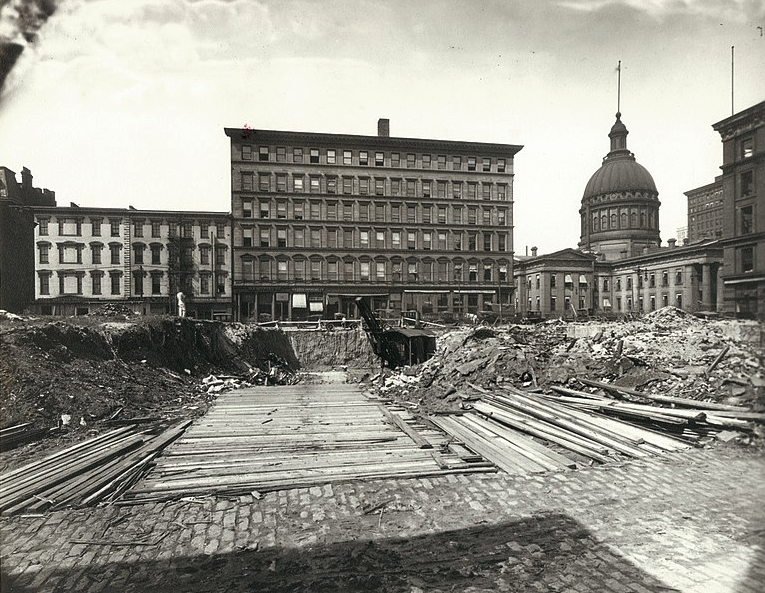HOK is one of the largest architecture and engineering firms in the world, but the vision for it came from humble beginnings. The “H” in HOK stands for “Hellmuth,” as in George Hellmuth, HOK’s legendary founding marketer. Hellmuth’s father was also named George Hellmuth and was also an architect. He and his brother, Harry Hellmuth, were partners in a firm called —what else— “Hellmuth & Hellmuth,” which had its heyday in the early 1900s in St. Louis, Missouri.
The practice was typical of that time, with the two partners and some draftsmen. Hellmuth & Hellmuth specialized in designing commercial buildings, projects for the Catholic Church and grand mansions for wealthy St. Louis business leaders. Their best-known work was the International Fur Exchange Building, now listed on the National Register of Historic Places.

When Hellmuth & Hellmuth secured a commission for a project, George and Harry hired draftsmen to help with the work. During the course of the project, the partners trained them to do the work properly, and gradually a more effective operation would emerge. When the project ended, often there was no new work to take its place, so Hellmuth & Hellmuth would lay those people off, and the firm would lose the positive effects of the training.
The partners would begin again to find new work, then hire another fresh team, often bringing in brand new people who they once again needed to train. The end of every project meant the firm was starting over again, and it lost good, seasoned people when the work ran out. Without knowing where the next project was coming from or who might be needed for the work, the firm was never able to plan its own future. Hellmuth & Hellmuth lurched from crisis to crisis.
Young George Hellmuth witnessed all of this and Hellmuth & Hellmuth’s boom and bust struggles made a profound impression. When he became an architect himself, he started to think about how to create the ideal architecture practice, one that didn’t fall into crisis and lose most of its staff and knowledge every time a project ended. While I was researching my book, Designing a World-Class Architecture Firm, I unearthed a paper Hellmuth wrote, called “The Depression-Proof Firm.” In it, Hellmuth outlined a series of insights that still offer great wisdom today:
1. Retain talented people. Hellmuth’s first insight was that talented people are the key to a successful architecture practice. Without talented people, no firm can plan for the future. Architecture firms should attract talented people, then keep them long-term to leverage their growing skills and abilities. Of course, keeping talented people long-term meant having steady work and that led to the next key insight.
2. Market full-time. Hellmuth’s second insight was that full-time marketing was essential to replace the current work before it was finished. Marketing to obtain a worthwhile new project took time —as much as five years. In addition, full-time marketing could be even more successful if supported by an effective, professional public relations program to cultivate awareness of the firm’s abilities and build relationships with potential clients.
3. Diversify your work/cities/services. Hellmuth’s third insight was to diversify the work of the firm to the maximum extent possible. He believed a diversified workload was superior to a focus on one type of building. His diversity insight also extended to geographic diversity. If work in one city was slow, work in another city could well keep a talented staff busy. Finally, he understood that diversified professional services —such as engineering and planning— were important to bring more work from each project in-house, rather than farming out much of that work to other firms.
4. Organize under specialized Leaders: Hellmuth’s fourth insight concerned specialized leaders. He proposed that each partner focus on a separate responsibility—marketing, design and production—for maximum efficiency. Partners in traditional firms did everything—sell, design and produce the work. Hellmuth believed that, by specializing, each partner could become an expert in his area of responsibility. This would also help avoid power struggles, since the partners would oversee separate domains.
5. Form a corporation not a partnership. Since Hellmuth’s father and uncle lost their firm when they retired, Hellmuth was determined to set his dream firm up differently. That’s why he and HOK’s other founders established it as a corporation instead of a traditional architecture partnership. They had the audacity to envision a firm that would outlast themselves. It’s a good lesson for all architects, designers and other creative services professionals: You must face your own mortality if you want the company you built to live on.